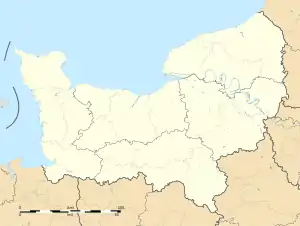Clécy | |
|---|---|
 A general view of Clécy | |
Location of Clécy | |
 Clécy  Clécy | |
| Coordinates: 48°55′01″N 0°28′54″W / 48.9169°N 0.4817°W | |
| Country | France |
| Region | Normandy |
| Department | Calvados |
| Arrondissement | Caen |
| Canton | Le Hom |
| Intercommunality | Cingal-Suisse Normande |
| Government | |
| • Mayor (2020–2026) | Raymond Carville[1] |
| Area 1 | 24.63 km2 (9.51 sq mi) |
| Population | 1,316 |
| • Density | 53/km2 (140/sq mi) |
| Time zone | UTC+01:00 (CET) |
| • Summer (DST) | UTC+02:00 (CEST) |
| INSEE/Postal code | 14162 /14570 |
| Elevation | 31–261 m (102–856 ft) (avg. 80 m or 260 ft) |
| 1 French Land Register data, which excludes lakes, ponds, glaciers > 1 km2 (0.386 sq mi or 247 acres) and river estuaries. | |
Clécy (French pronunciation: [klesi] ⓘ) is a commune in the Calvados department in the Normandy region in northwestern France.
In 1932 it was awarded the title The Capital of Norman Switzerland by the Tourism Minister Monsieur Gourdeau.
Geography

Clécy is on the River Orne, in the middle of Norman Switzerland, about 35 kilometres (22 mi)s south of Caen. Covering 2,463 hectares (6,090 acres) it is the largest commune in the canton of Thury-Harcourt.
Called the "Capital of Norman Switzerland", this village owes its fame to the rugged and verdant Armorican massif, with valleys through which the Orne flows.
Plenty of outdoor activities are available: kayaking, paragliding, climbing, hill walking and mountain biking, taking advantage of the geology of Norman Switzerland.
History
The name "Clécy" is mentioned in 860 in the reign of Charles the Bald.
When French cantons were created, Clécy was the capital of the canton. This ceased to be the case after restructuring in 1801.
Clécy has a wealth of historical treasures: Châteaux and manor houses are spread all over Clécy and its surroundings. The Château de la Landelle is one of the oldest.
More recently, painters such as Paul-Émile Pissarro, Moteley and Hardy have painted landscapes around Clécy.
Administration

| Election | Mayor | Party | Occupation | |
|---|---|---|---|---|
| 1989 | Claude Hergault | SE | ||
| 2008 | Michel Bar | SE | Farmer | |
Population
| Year | Pop. | ±% p.a. |
|---|---|---|
| 1968 | 1,238 | — |
| 1975 | 1,187 | −0.60% |
| 1982 | 1,197 | +0.12% |
| 1990 | 1,182 | −0.16% |
| 1999 | 1,252 | +0.64% |
| 2009 | 1,238 | −0.11% |
| 2014 | 1,251 | +0.21% |
| 2020 | 1,305 | +0.71% |
| Source: INSEE[3] | ||
Its inhabitants are called Clécyens in French.
Economy
- Fromagerie Vallée (Valley Cheesemaker)
Sights

- The Château de La Landelle is one of the oldest monuments in the village. At its base it is in the form of a cross, originally on one floor, but was changed to two floors when the wings were reworked. In the Second World War it was occupied by the Germans.
- Rochers des Parcs (Park rocks)
- Pain de sucre (Sugarloaf)
- Musée Hardy (Hardy Museum)
- Musée du chemin de fer miniature (Museum of miniature trains)
- Manoir de Placy (Placy Manor) (16th century)
- Eglise St Pierre (St Paul's church) (15th century)
- Clécy Viaduct (1866)
Personalities
- Paul-Émile Pissarro prolific landscape painter who moved to Clécy in 1936.
See also
References
- ↑ "Répertoire national des élus: les maires" (in French). data.gouv.fr, Plateforme ouverte des données publiques françaises. 13 September 2022.
- ↑ "Populations légales 2021". The National Institute of Statistics and Economic Studies. 28 December 2023.
- ↑ Population en historique depuis 1968, INSEE
External links
- Clécy sur le site de la communauté de communes
- Chemin de fer miniature de Clécy Archived 23 March 2009 at the Wayback Machine